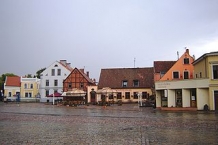Cycle Tour Baltic from Klaipeda to Tallin
Planned tour
Actions
![]()
Please wait - map data are loading
Added on 17 Apr 2015,
last edited by edmont on 07 Jul 2015
Actions
Cycle route metrics
planned
ridden
Total distance in km
995
0
Cumulative elevation gain in m
3.736
0
Avg. slope uphill in %
0,38
-
Cumulative elevation loss in m
3.717
0
Information about rights to the gps-track data | |
|---|---|
Rights owner | edmont & Ottocolor & waymarkedtrails |
Rights characteristic / license | by-sa: CREATIVE COMMONS Attribution-ShareAlike |
Link to the description of the license | |
GPX file taken from | |
GPX file uploaded | by edmont on 07 Jul 2015
|
Track points in total
6.601
0
Track points per km (avg)
7
0
Start/endpoint
Start location
Klaipėda, Klaipeda County, LT (1 m NHN)
End location
Tallinn, EE (20 m NHN)
Beds4Cyclists, worth visiting and infrastructure
Name and address
Latitude / Longitude
Phone
Fax
Mobile
Type of accommodation
Rating for cyclists
Route km
Dist. to route
Elevation
0 km
0,8 km
9 m
0 km
3,1 km
5 m
0 km
0,2 km
8 m
0 km
0,2 km
9 m
Information about copyright | |
|---|---|
Rights owner | |
Rights characteristic / license | by-sa: CREATIVE COMMONS Attribution-ShareAlike |
Link to the description of the license | |
Image taken over from | commons.wikimedia.org/wiki/File:Klaipeda-Stadtrundgang_02.jpg |
Image has been uploaded | by biroto-Redaktion on 04 Nov 2011
|
Information about copyright | |
|---|---|
Rights owner | |
Rights characteristic / license | by-sa: CREATIVE COMMONS Attribution-ShareAlike |
Link to the description of the license | |
Image taken over from | commons.wikimedia.org/wiki/File:Klaipeda_-_Annchen_von_Tharau_with_Folklore_Group.jpg |
Image has been uploaded | by biroto-Redaktion on 04 Nov 2011
|
Information about copyright | |
|---|---|
Rights owner | |
Rights characteristic / license | by: CREATIVE COMMONS Attribution |
Link to the description of the license | |
Image taken over from | commons.wikimedia.org/wiki/File:Klaipeda_Theaterplatz_Ost.jpg |
Image has been uploaded | by biroto-Redaktion on 04 Nov 2011
|
Klaipėda (German: Memel) is a city in Lithuania situated at the mouth of the Danė River where it flows into the Baltic Sea. It is the third largest city in Lithuania and the capital of Klaipėda County.
The city has a complex recorded history, partially due to the combined regional importance of the Port of Klaipėda , a usually ice-free port on the Baltic Sea, and the Akmena - Danė River. It has been controlled by the Teutonic Knights, the Duchy of Prussia, the Kingdom of Prussia, the German Empire, the Entente States immediately after World War I, Lithuania as a result of the 1923 Klaipėda Revolt, and the Third Reich following the 1939 German ultimatum to Lithuania. The city was incorporated into Lithuania during its tenure as a Soviet Socialist Republic and has remained within Lithuania following its re-establishment as an independent state.
Historical
Klaipėda's main attractions are the historic buildings in the city's centre, dating from the 13th to 18th centuries. Some of its older buildings have picturesque half-timbered construction, similar to that found in Germany, France, England, Denmark and southern Sweden. Other places of interest include:
- The remnants of the Klaipėda Castle
, built in the 13th century by the Teutonic Order. It had a massive bulk and a quadrangular tower, surrounded by the ramparts and brick bastions. It lost importance after the Russian occupation from 1756 to 1762, and thenceforth started to decay.
- The Žardė ancient settlement, situated on the right bank of the Smiltelė River. It is dated to the late Iron Age (10th century), and was inhabited until the 16th century.
- The remnants of the so-called 'Dutch' defence system around the entire town from the 17th-18th centuries.
- The maritime museum in Fort Wilhelm, built at the end of the 19th century at the spike of the Curonian Spit.
Museums
Information about copyright | |
|---|---|
Rights characteristic / license | by-sa: CREATIVE COMMONS Attribution-ShareAlike |
Link to the description of the license | |
Input taken over from: |
Wikipedia contributors, 'Klaipėda', Wikipedia, The Free Encyclopedia, 7 March 2012, 13:06 UTC, http://en.wikipedia.org/w/index.php?title=Klaip%C4%97da&oldid=480656813 [accessed 8 March 2012] |
taken over / edited on | 08 Mar 2012 - 25 Aug 2016
|
taken over / edited by |
|
0 km
0,3 km
10 m
Hours of opening
October – April: Monday – Friday 9.00-18.00 h
May: Monday – Friday 9.00-18.00 h, Saturday 10.00-16.00 h
June – August: Monday – Friday 9.00-19.00 h, Saturday – Sunday 10.00-16.00 h
September: Monday – Friday 9.00-18.00h, Saturday 10.00-16.00 h
Languages spoken:
lietuvių kalba
![]()



